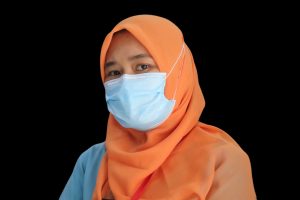The Role of the Healthcare Provider
Infection prevention and control measures are everyone’s responsibility. The role of healthcare providers is to ensure safe and effective infection prevention and control practices are upheld, evidence-based best practice guidelines are implemented, and continued competency in institutional policies are maintained.
All healthcare providers are required to apply infection prevention and control measures when providing care to clients. It is important to educate and support clients, as well as their visitors, about infection prevention and control practices and how to prevent healthcare-associated infection. Continually updating your infection prevention and control knowledge and skills is essential to reduce the spread of infection, role-model positive health promotion, and reduce health challenges or inequities clients encounter related to infection prevention and control.

An essential role of healthcare providers is to ensure effective infection prevention and control strategies are in place to identify, analyze, assess, and manage any potential risks; thereby to advocate for the safety of clients, the healthcare team, and the healthcare environment.
Both regulated and unregulated healthcare providers must follow infection prevention and control standards, guidelines, and best practices. Some professional colleges have specific standards for their discipline (e.g., occupational therapists), whereas others may refer to a list of resources to support their discipline’s professional requirements (e.g., registered nurses and physiotherapists). As healthcare providers, it is your role to maintain competency in infection prevention and control practices by staying up to date on new policies and changes in practice. It is also your role to support your colleagues to maintain competency by reinforcing proper practice and sharing knowledge with peers of policies changes.
Clinical Tip
What is an infection prevention and control risk assessment?
It’s important to understand how and when to perform a risk assessment. A risk assessment is performed to decrease the risk of transmission of microorganisms and to promote a healthy workplace environment.
Before entering a healthcare environment or providing any care to a client, you need to perform a risk assessment.
The goal is to assess if there are any risks of infection, and to determine which infection prevention and control interventions are required to prevent the transmission of infection during the provision of client care.
This must be done each time you interact with a client because their environment and health status continuously change.
Ask yourself:
- What type of care is required for the client?
- What is the client’s diagnosis or infection status, and is the client exhibiting any signs or symptoms?
- What type of environment are you entering to provide client care?
- Will I be exposed to or at risk of exposure to body fluids (blood, excretions, or secretions) or be within 2 meters of the client?
- Will my hands be exposed to or at risk of exposure to blood, body fluids, or contaminated equipment?
- Will my face (e.g., mucous membranes of the eyes, nose, mouth) come into contact with or be at risk for coming into contact with blood or body fluids due to the spraying of fluids (e.g., coughing, sneezing, aerosol particles generated by medical procedures)?
- Will my clothing (e.g., uniform) or body (e.g., exposed skin) come into contact with or be at risk for coming into contact with blood, body fluids, or contaminated equipment due to touching or spraying of fluids?
In Chapter 2, you will learn more about performing an infection prevention and control risk assessment to determine the practices needed to prevent the transmission of infection.
Infection Prevention and Control Resources
The following is a list of infection prevention and control resources that you can use to learn more about infection prevention and control standards, guidelines, and best practice guidelines.
Note: Each healthcare discipline may have additional responsibilities according to their health regulatory colleges, as well as from their employer or workplace. Refer to the Occupational Health and Safety Act for more information about health and safety in the workplace (https://www.ontario.ca/laws/statute/90o01 and https://www.ontario.ca/document/guide-occupational-health-and-safety-act).
Infection prevention and control guidelines are mandated in healthcare settings to maintain safety, provide quality care, and protect clients, visitors, and healthcare providers from the transmission of microorganisms that cause infections. Healthcare providers and organizations must be accountable and responsible to educate, train, and maintain competency in infection prevention and control practices, and adhere to healthy workplace policies. Continued compliance and implementation of hand hygiene, routine practices (also referred to as standard precautions), and additional precautions, as well as cleaning, disinfecting, and sterilization of medical equipment and surfaces, is essential to maintain safety within healthcare settings. Healthcare providers have the responsibility to comply with infection prevention and control practices according to the Occupational Health and Safety Act (https://www.ontario.ca/laws/statute/90o01). It is important to review and follow your healthcare setting infection prevention and control policies.
Healthcare providers are in a unique position to educate and empower the public with evidence-based knowledge about health promotion and preventive measures related to infection prevention and control. Through health promotion and education, healthcare providers can inform the public about safe and effective prevention techniques, and address misinformation found on social media. Reassurance and support from health providers can play a significant role in promoting public awareness and healthy behaviours. Educating clients and visitors on infection prevention and control practices will be discussed further in the next chapters.
Points of Consideration: Interprofessional Collaboration
As a healthcare provider, you are responsible for recognizing and applying evidence-based strategies to prevent the risk of infection. Remember, as a healthcare provider, you work as an interprofessional team member. It is important to consult your colleagues as you make decisions to prioritize optimal care related to infection prevention and control. Collaboration is paramount because others may identify risks that you have not considered. Working together, facilitating open communication, and building trusting relationships promotes client-centred care and a safe working environment.
Digital Story with Gwenda Bartley

